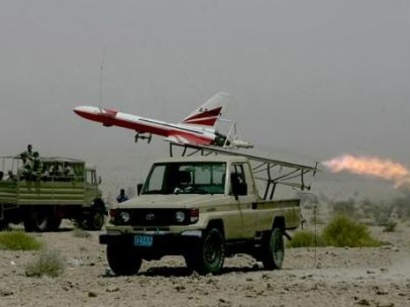
Iran’s authorities announced today that Iran’s Revolutionary Guards Corps (IRGC) have intercepted and downed an ‘alien’ drone during the first day of the ‘Great Prophet 8’ exercise taking place in Southern Iran this week. It is not clear from the announcement whether the event is part of the training program or an actual intercept involving a foreign unmanned system has taken place.
In the past two years Iran intercepted several US drones, among them a CIA Lockheed Martin RQ-170 and Boeing/InSitu Scan-Eagle, supporting the US Navy, both were captured virtually intact. Apparently, the Iranian exercise planners have included these scenarios in their plan. “During the opening phase of the ‘Great Prophet 8’ exercise IRGC’s electronic warfare systems detected signals showing that alien drones were trying to enter the country (airspace),” Spokesman of the Wargames General Hamid Sarkheili told reporters on Saturday evening. Sarkheili said the IRGC is now in possession of the pictures taken by the drone and will release them if Okayed by the country’s senior commanders. While the Fars news agency refers to the incident as an actual intercept of a foreign UAS, another agency, PressTV has translated the same news item with a different tone, referring to the drone as a ‘mock spy drone’, understood to be part of the exercise scenario.
According to Sarkheili drones are extensively used throughout the exercise, he noted that in addition to reconnaissance, UAVs will also be used in attack missions, as ‘suicide drones’, capable of attacking targets in positions difficult for targeting by other weapon systems. Deputy Defense Minister for Industrial and Research Affairs Mohammad Eslami recently confirmed that Iran is developing a ‘strategic UAV’ designed for long-range missions. “We hope to soon unveil new strategic drones which can fly up to 30,000 feet in altitude and 24 hours of nonstop flight.” Eslami said. noting that Iran is already involved in the production and development of 20 different UAS. The new drone could be unveiled in May this year. Sarkheili also confirmed that a new anti-helicopter weapon system, utilizing a shoulder-launched 20mm missile will also be tested. The new weapon can engage helicopters from a distance of 1,400 meters.
Referring to the operational capabilities of Iranian UAVs, IRGC Air Force Brigadier General Amir Ali Hajizadeh, referred to a recent mission of a UAV known as ‘Ayub’ over southern Israel, where the Iranian drone operated by the Iranian-supported, Lebanese-based insurgent organization Hezbollah was sent on a reconnaissance mission over Israel.
While Israeli authorities acknowledged the UAV had penetrated 60-70 km into their airspace, According to Hajizadeh the drone actually had a 400 km flight in Israeli controlled airspace (probably referring to the route the drone passed from the point it crossed the Israeli Lebanese border over the Mediterranean to the point where it crossed the Israeli coastal line north of the Gaza strip.)
According to Hajizadeh this was not the first occasion an Iranian drone has flown over Israel, as the drone is equipped with the means to enable it to fly over Israel unnoticed, conduct its mission and return home. Hajizadeh said that on a specific mission in October 2012, code named ‘Operation Hussein Ayub’ the drone was eventually detected and shot down by Israeli F-16s was directed at aerostats deployed in that area. Iran claimed the drone that was shot down in that mission has reached the Dimona Nuclear Research Center in the North Eastern Negev Desert.
Referring to the operational capabilities of Iranian UAVs, IRGC Air Force Brigadier General Amir Ali Hajizadeh, referred to a recent mission of a UAV known as ‘Ayub’ over southern Israel, where the Iranian drone operated by the Iranian-supported, Lebanese-based insurgent organization Hezbollah was sent on a reconnaissance mission over Israel.
While Israeli authorities acknowledged the UAV had penetrated 60-70 km into their airspace, According to Hajizadeh the drone actually had a 400 km flight in Israeli controlled airspace (probably referring to the route the drone passed from the point it crossed the Israeli Lebanese border over the Mediterranean to the point where it crossed the Israeli coastal line north of the Gaza strip.)
According to Hajizadeh this was not the first occasion an Iranian drone has flown over Israel, as the drone is equipped with the means to enable it to fly over Israel unnoticed, conduct its mission and return home. Hajizadeh said that on a specific mission in October 2012, code named ‘Operation Hussein Ayub’ the drone was eventually detected and shot down by Israeli F-16s was directed at aerostats deployed in that area. Iran claimed the drone that was shot down in that mission has reached the Dimona Nuclear Research Center in the North Eastern Negev Desert.
In an interview in December 2012 the Israel Air Force commander Maj. General Amir Eshel acknowledged the IAF is making preparations to intercept larger and smaller drones, which are even harder to identify, than the UAV intercepted over the Negev in October. “It’s not new that we are readying ourselves against this threat,” Eshel said, referring to Hezbollah. “This field is developing and already now it requires us to come up with comprehensive answers.” However, Eshel was short of promising airtight protection. “In defense there is never a rock-hard wall that nothing can breach. The goal is to be prepared for the main and significant [threat] and to disregard the less important. Eshel told the Israeli newspaper Haaretz.

















